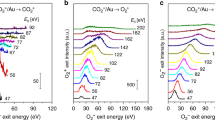2
and N2O with Cs are discussed. If the molecules interact with a metal surface the nonadiabaticity is triggered by harpooning, i.e. resonant ionization and acceleration in the image field, and subsequent dissociation. From recent experiments with state-selected N2O molecules on Cs [1] the range of harpooning reactions is extended. From exoemission of N2O in the first excited bending mode and its suppression in the ground state, it is concluded that a molecular affinity level may be lowered by more than 3.5 eV in front of a metallic Cs surface. This is a hint that harpooning is more common than expected.
Similar content being viewed by others
Author information
Authors and Affiliations
Additional information
Received: 24 March 1998/Accepted: 21 August 1998
Rights and permissions
About this article
Cite this article
Greber, T. Probing harpooning and dissociation in gas–surface reactions by exoemission . Appl Phys A 67, 701–704 (1998). https://doi.org/10.1007/s003390050841
Issue Date:
DOI: https://doi.org/10.1007/s003390050841




